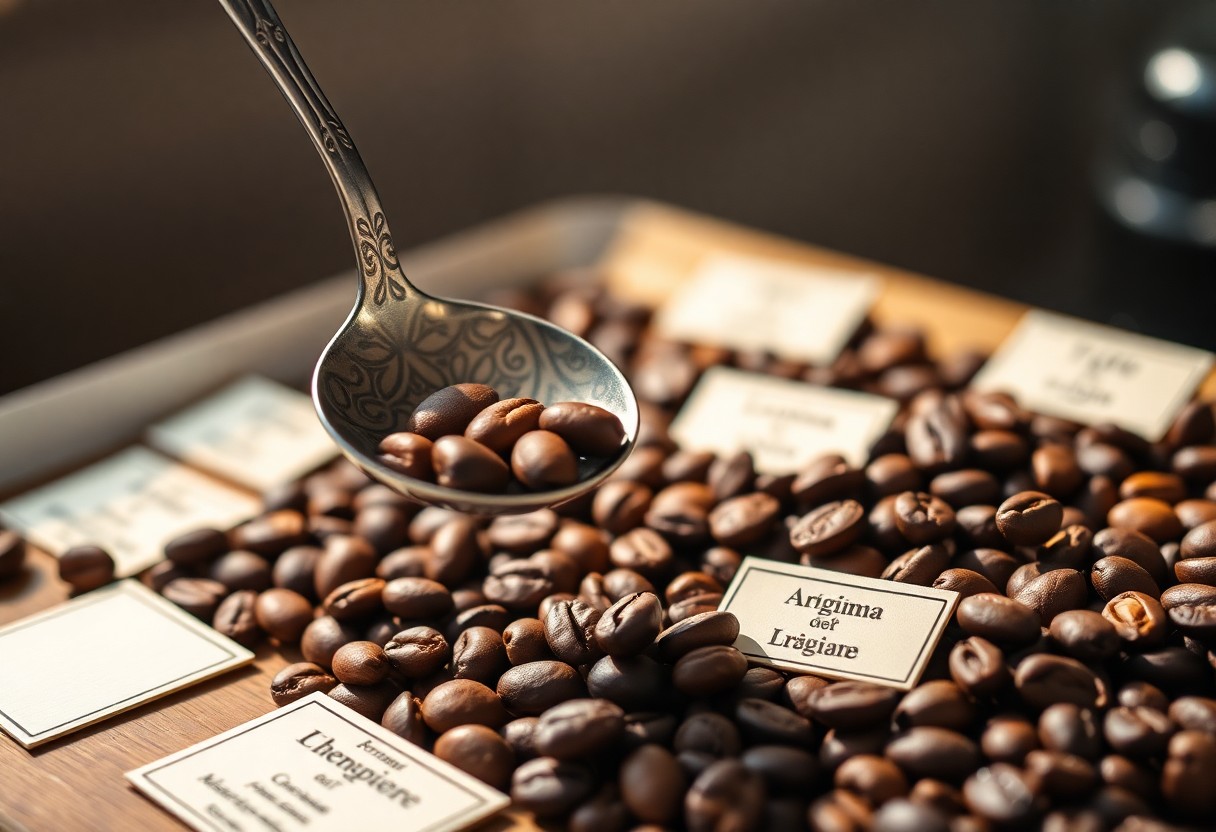Most coffee lovers know that aroma plays a vital role in the overall tasting experience, but did you know that your sense of smell actually provides up to 90% of what you perceive as flavor?
Understanding the complex world of coffee aromatics can enhance your appreciation of this beloved beverage, allowing you to identify subtle notes and profiles unique to each brew.
In this post, you’ll discover the fascinating science behind those intoxicating scents and how they influence your sensory experience, ultimately making each cup of coffee a richer adventure.
Key Takeaways:
- The complex aromas of coffee are a result of various volatile compounds that contribute to its flavor profile and overall experience.
- Human olfactory senses can detect and differentiate thousands of aromas, making them imperative for fully appreciating the nuances of coffee.
- Understanding the science behind coffee aromatics can enhance brewing techniques and improve the overall sensory experience of coffee consumption.
The Chemistry Behind Coffee Aromatics
Understanding the nuances of coffee aroma requires delving into the chemistry of its many components. Coffee contains over 800 different volatile compounds, which are responsible for its unique fragrances.
These compounds arise during the roasting process and can be altered by factors such as bean origin and roast level. The combination of these elements creates complex aromatic profiles that you can discern while enjoying your cup of coffee.
Key Compounds That Create Aroma
Among the key compounds responsible for coffee’s rich aroma are acetic acid, aldehydes, and esters. Acetic acid introduces a slight tartness, while aldehydes bring fruity tones. Additionally, esters contribute to the sweetness and complexity of the overall aroma. Each of these compounds interacts with others to create a symphony of scents that enhance your coffee experience.
The Role of Volatile Organic Compounds
Volatile organic compounds (VOCs) play a significant role in the aromas you perceive. These compounds evaporate readily at room temperature, allowing them to reach your nose quickly when you brew or sip coffee.
Examples of VOCs in coffee include 2-furfurylthiol, which provides that distinct roasted note, and linalool, which gives off a floral scent. The presence and concentration of these VOCs can vary based on the roast level, brewing method, and even the freshness of the beans, making each coffee experience unique.
With over 1,500 known VOCs in the world of coffee, it’s fascinating to know how the roasting temperature can influence their release. For instance, lighter roasts tend to retain more of the fruity and floral notes, thanks to a greater presence of aromatic compounds that showcase their terroir.
On the other hand, darker roasts may introduce more bitter flavors, while diminishing some of the subtler aromas. This interplay of temperature, time, and chemical reactions makes each cup a distinct aromatic journey, allowing you to appreciate the intricacies of your favorite brew.

How Your Nose Influences Taste Perception
Your nose plays a pivotal role in how you perceive the overall flavor of coffee. The majority of your perceived taste actually comes from your ability to smell. In fact, studies show that over 80% of taste relies on olfactory senses. When you sip your coffee, the aromas travel through the back of your throat to the nasal cavity, allowing you to experience a richer, more nuanced flavor profile than taste buds alone can provide.
The Connection Between Smell and Flavor
When you take a sip of coffee, the aroma compounds interact with your olfactory receptors, directly influencing what you identify as flavor. This interplay involves thousands of volatile compounds, each contributing unique notes such as fruity, nutty, or floral characteristics. Your brain integrates these olfactory signals with taste sensations to create the complete experience, making aroma indispensable in your coffee journey.
The Psychology of Aroma in Coffee Enjoyment
The psychology of aroma heavily influences your overall enjoyment of coffee. Research shows that positive olfactory experiences can enhance your perception of flavor and make the consumption of coffee more pleasurable.
For instance, familiar smells can evoke memories or emotions, further enhancing your taste experience. This connection between flavor and sentiment demonstrates that your enjoyment of coffee is not just about the drink itself, but your personal associations with its aromas.
Additionally, specific aromas can trigger various emotional responses; a warm, chocolatey scent may remind you of childhood comforts, while bright, citrus notes can evoke feelings of refreshment and vitality.
These psychological connections often encourage you to seek out certain coffee flavors based on past experiences, shaping your preferences and choices in the world of coffee.
By understanding the psychological impact of aroma, you can further refine your appreciation for coffee, recognizing that each cup is not only a drink but an experience etched with personal flavor narratives.
The Journey from Bean to Brew: Aroma Development
A coffee bean’s aroma begins its development long before it’s brewed, influenced by various factors from growth to processing. Factors such as altitude, climate, and soil quality dictate the chemical compounds that form within the bean.
As the green coffee beans undergo roasting, a series of Maillard reactions and caramelization transforms them, enhancing the aroma profile with rich and complex notes that ultimately shape your coffee experience. Mastery of this journey can significantly influence the aromatic outcome in your cup.
The Impact of Coffee Processing Methods
Brewing Techniques That Enhance Aroma

Aromatic Profiles: A Sensory Exploration
Diving into the aromatic profiles of coffee offers an engaging sensory experience that transcends mere taste. By identifying specific scents, you can better appreciate the complex layers and subtleties of your brew.
Each coffee bean type carries its own profile shaped by factors such as geography, processing methods, and roasting techniques. This exploration not only enriches your palate but also deepens your understanding of what makes each cup distinctly unique.
Defining Common Coffee Aromas
Aromatic coffee notes can range from fruity to nutty, floral to earthy. For instance, you might detect bright citrus aromas in a Costa Rican coffee, while a Sumatran blend might present rich, earthy undertones. Recognizing these common aromas enhances your ability to select beans that align with your preferences and create a more fulfilling coffee experience.
The Cultural Context of Coffee Aromatics
Coffee does not only serve as a beverage; it reflects cultural identities and traditions. Different regions and communities have developed unique aroma preferences over centuries, crafting their roasting and brewing methods around local tastes. This cultural lens adds additional richness to your coffee experience, allowing you to taste and appreciate not just your drink, but also the stories and histories behind each aromatic note.
Your exploration of coffee aromatics doesn’t happen in isolation. For example, Ethiopian coffee, often celebrated for its fruity and floral aromas, has deep ties to Ethiopian culture and rituals, including traditional coffee ceremonies.
In contrast, Italian espresso embodies a sense of community and social connection with its bold, rich aromas that encourage conversation. Each region’s unique traditions shape how you experience and appreciate not only the smells but also the emotional connections associated with your coffee choices.
Elevating Your Coffee Experience: Practical Tips
Enhancing your coffee experience involves a few simple yet effective practices. Start by using fresh, high-quality coffee beans that suit your taste profile. A clean brewing equipment is also necessary to maintain the flavor integrity. Consider exploring brewing methods like French press or pour-over, which can accentuate different aromatic compounds.
Engage in active tasting, focusing on the various flavors to understand their origins better. Lastly, to deepen your knowledge, check out this insightful article on Identifying A Coffee’s Origin By Volatile Aromatic Compounds. Any step you take towards exploration adds flavor to your coffee journey.
How to Sniff Your Coffee Like a Pro
To truly appreciate your coffee, mastering the art of sniffing is crucial. Begin by gently swirling your cup to release the aromas. Bring the mug close to your nose, inhaling deeply without overwhelming yourself. Focus on identifying specific notes, such as fruity or nutty characteristics, which can reveal the coffee’s origin. Practice makes perfect; the more you sniff, the better you’ll become at decoding those elusive aromatic compounds.
Pairing Coffee with Food to Enhance Aromatic Enjoyment
Pairing food with coffee can elevate your sensory experience significantly. The right combination brings out unique flavors and complements the coffee’s aromatic profile. For instance, a chocolatey coffee can pair beautifully with desserts like chocolate cake or biscotti, unlocking deeper notes of sweetness.
Light, fruity coffees often match well with pastries or breakfast items, enhancing both the coffee and the food. Pay attention to the flavor contrasts and complements that can enhance your tasting experience.
Experimenting with different food pairings can lead to delightful discoveries. The acidity of a bright coffee may shine alongside citrus-based dishes, while a rich, dark brew can stand up to savory breakfasts like eggs or bacon.
Each pairing presents an opportunity to uncover new layers within your coffee, enhancing both your beverage and your meal. The right food can not only highlight existing notes but also introduce new flavors, creating an extraordinary sensory experience for your palate.
To wrap up
With these considerations, you can appreciate the intricate science behind coffee aromatics and the powerful role your nose plays in your coffee experience. Understanding how volatile compounds interact with your sense of smell can enhance your tasting sessions, allowing you to identify distinct flavors and aromas. By engaging fully with your olfactory perceptions, you elevate your enjoyment of coffee, making each cup not just a beverage but an exploration of sensory delight.
FAQ
How does the sense of smell affect our perception of coffee?
The sense of smell plays a vital role in how we perceive flavors, including those in coffee. Our olfactory receptors interact with aromatic compounds in coffee, enhancing the overall tasting experience. This means that much of what we perceive as flavor is actually derived from the aromas that travel through the air and stimulate our olfactory senses, making smell an important component of coffee enjoyment.
What are coffee aromatics, and why are they important?
Coffee aromatics are the volatile compounds released from coffee beans during brewing. They include various substances that contribute to the fragrance and flavor profile of the coffee. These aromatics not only help to create the delightful smell we associate with freshly brewed coffee but also influence our taste perceptions. A complex array of these compounds enhances the coffee’s overall character, making them a key aspect of quality coffee appreciation.
Can the brewing method affect the aroma of coffee?
Yes, the brewing method significantly impacts the extraction of coffee aromatics. Different techniques—such as pour-over, espresso, or French press—alter the brewing time, temperature, and water-to-coffee ratio, all of which can influence the final aroma. For example, a French press may produce a fuller body and more robust aroma due to the prolonged steeping time, while espresso often highlights sharper, bolder scents because of its concentrated brewing process.
How can I enhance the aromatic experience of my coffee at home?
To enhance the aromatic experience, consider starting with high-quality, fresh coffee beans that have been properly stored. Additionally, grind your beans just before brewing to preserve their aromatic compounds, and experiment with different brewing methods to discover which one you enjoy the most. You can also try warming your coffee cup in advance, which can help release the aromas when you brew and sip, amplifying your sensory experience.
Why is the temperature of the coffee important for aroma perception?
Coffee temperature is important for aroma perception because heat helps to release the volatile compounds that give coffee its unique fragrances. When coffee is too hot, our sense of smell can be diminished because the heat can cause discomfort. Conversely, as the coffee cools, more of the aromatic compounds become detectable, allowing for a fuller appreciation of the coffee’s scent. Tasting while adjusting the temperature can reveal hidden notes that may not be apparent at extreme temperatures.
